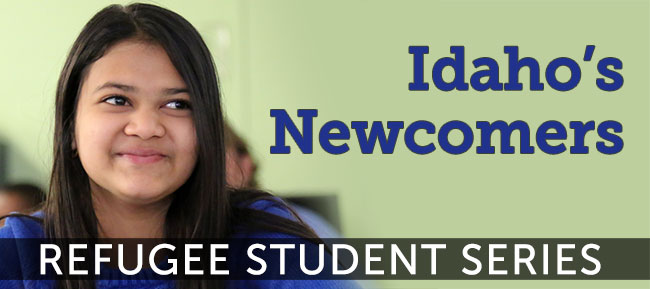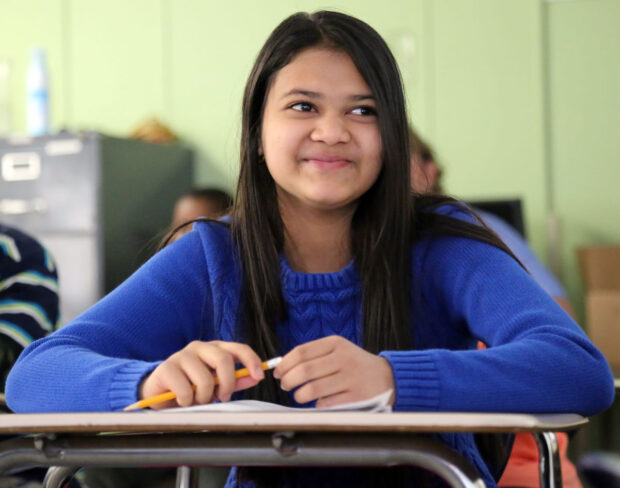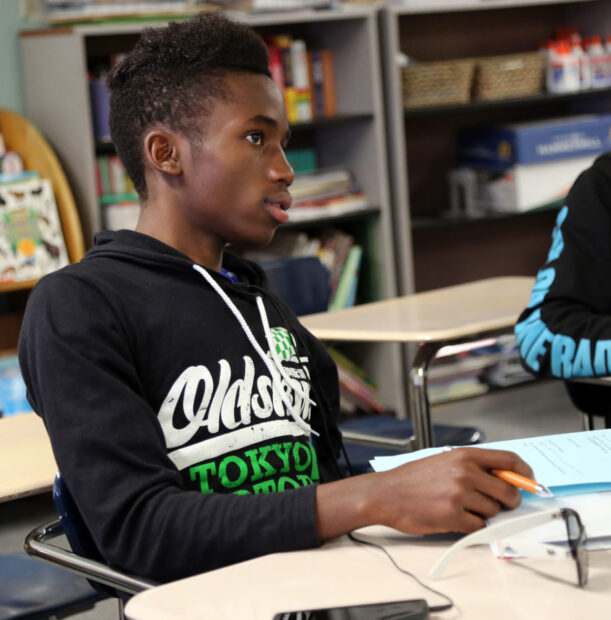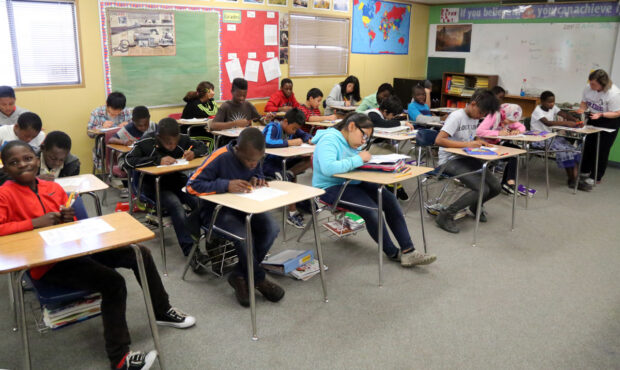Some refugee students at Boise’s Hillside Junior High School remember the schools in their homelands — where teachers hit their students, or where teachers feared being hit by students.
Then there are the refugee students who have spent little time in any classroom.
 “You have to learn how to be a student,” said Rita Hogan, a teacher in Boise’s English Language Development program. “And that’s tough, when you’re a seventh-grader, and you’re learning algebra.”
“You have to learn how to be a student,” said Rita Hogan, a teacher in Boise’s English Language Development program. “And that’s tough, when you’re a seventh-grader, and you’re learning algebra.”
Tucked against the fringes of the Boise foothills, Hillside is home to one of the district’s Bridge Programs. The programs provide intense English language training to newcomer students. Depending on how much help they need, students may be in the program for up to two years. Occasionally, students are kept in the program longer.
The bridge program isn’t open only to Boise’s 1,019 refugee students, who come from 45 countries and speak 73 languages. But many of the refugee students need to overcome more barriers than just their language.
Many arrive at Hillside scarred and scared — overwhelmed by their new surroundings and unsure how to interact with their new classmates.
“I just watched,” said Eric Bengana, an eighth-grader from Burundi.
“It was good if they looked at you,” said Zaid Al Aayedi, an eighth-grader from Iraq, speaking of his new Boise classmates. “They want to get to know you more.”
Other students struggled with the expectations of a new school environment. Aishah Mohamad Rafik, an eighth-grader from Malaysia, spoke about struggling to learn how to open a locker.
Hogan remembers it well.
“Their lockers are right with everyone else,” she said. “It’s just so foreign to them.”
But Hogan also sees the progress Aishah has made in her six months in Boise. She has gone from a student who did not know a word of English to one willing to speak about her transition.

The teachers see other students making progress.
Ninth-grader Josue Butinda talks enthusiastically about learning U.S. history, and making friends with classmates from the U.S. and Japan. Teachers see a flair for leadership in Josue — as well as an eye for fashion and a knack for athletics. This year, Josue played basketball for Hillside’s ninth grade team, and soccer for Capital High School.
But like many of his classmates, Josue talks about the abuse he saw in classrooms in the Democratic Republic of the Congo and Uganda — and one teacher in particular, who would chop off students’ hair if they misbehaved. “He’d just pull your hair and give it to you back.”
As a group of refugee students gathered recently in a Hillside conference room, such stories flowed, one to the next. After the students talked openly about the violence they’d seen in schools in their homelands, even Hogan was surprised. “They don’t come right out and tell their stories,” she said. “You have to earn that trust.”
The transition to an American school — safer and more structured — is a marked difference from the interrupted education many refugees receive in their native lands.

“A lot of schools are really struggling to develop refugee programs that catch these kids up on these academic issues,” said Julie Sugarman, a policy analyst with the Migration Policy Institute in Washington, D.C.
Laura Boulton works daily to help students catch up. A math teacher at Boise’s Borah High School, Boulton has three Bridge Program classes, with 90 immigrant and refugee students. That number is always changing; she expects to add a couple more students in May, in the final weeks of the school year.
“The minute they get here, we want them in school,” she said. “It’s not their fault they get here a month before the end of school.”
The students arrive from all over the world — from Africa and the Middle East, from Southeast Asia and Latin America. And their skills vary widely. Some are learning from scratch, but Boulton has also had students who have taken pre-calculus classes in their homeland.
A unifying thread is their work ethic. The newcomer students give their full effort, “even if they don’t know what they’re doing,” she said.
“I don’t have classroom management issues, ever,” she said.
Boulton is herself an immigrant; she is of Chinese descent and her family moved from Malaysia when she was 8. She is sensitive to the refugee students’ life experience, to the point that she no longer watches the news. She says she learns all she needs to know about world events by looking in the eyes of students who have witnessed beheadings and land mine explosions.
Boulton can speak to the students, as one newcomer to another. But she chooses to help her students adjust to the realities of high school in America, from picking a cell phone package to planning to attend the prom.
“I try not to muddle their life with the politics,” she said. “They’re probably going home and getting plenty of that.”
In English and social studies classes, however, it’s impossible to sidestep politics. Two staples of junior high school English curriculum illustrate this point.
Harper Lee’s “To Kill a Mockingbird” is required reading for Hillside ninth-graders, but its exploration of racism takes on added resonance for the refugee students. “These guys get it,” said Hogan.
Meanwhile, Anne Frank’s “The Diary of a Young Girl” poses a dilemma, because its storyline is disturbing to students who have only recently fled with their families.
The Bridge Program students face many of the same demands and challenges as their native-born classmates. Except, for the refugee students, the obstacles are higher.
Today’s learning model, predicated on oral communication, can be especially intimidating to students who are scrambling to pick up English skills. The time-consuming Smarter Balanced Assessment Consortium exams are demanding for any student, and Bridge Program students are expected to take the test at the end of their second year.
All the academic and social challenges are layered atop a challenge of the times. The Bridge Program refugee students are assimilating into a new culture in the midst of a national debate over immigration and refugee policy.
With that comes added pressure. The Bridge Program may provide native-born students with their first exposure to a Muslim student, or a student from a faraway nation. That means the refugee students often make that lasting first impression.
“They take that responsibility really seriously,” said Jill Ball, the lead teacher in the Hillside Bridge Program.

This series at a glance
Day One: Refugee programs become embroiled in a national debate
Day One: In Boise’s Bridge Programs, immigrants learn to be students
Day Two: Twin Falls reaffirms support for refugee program
Day Two: Refugee education hinges on a co-teaching model
